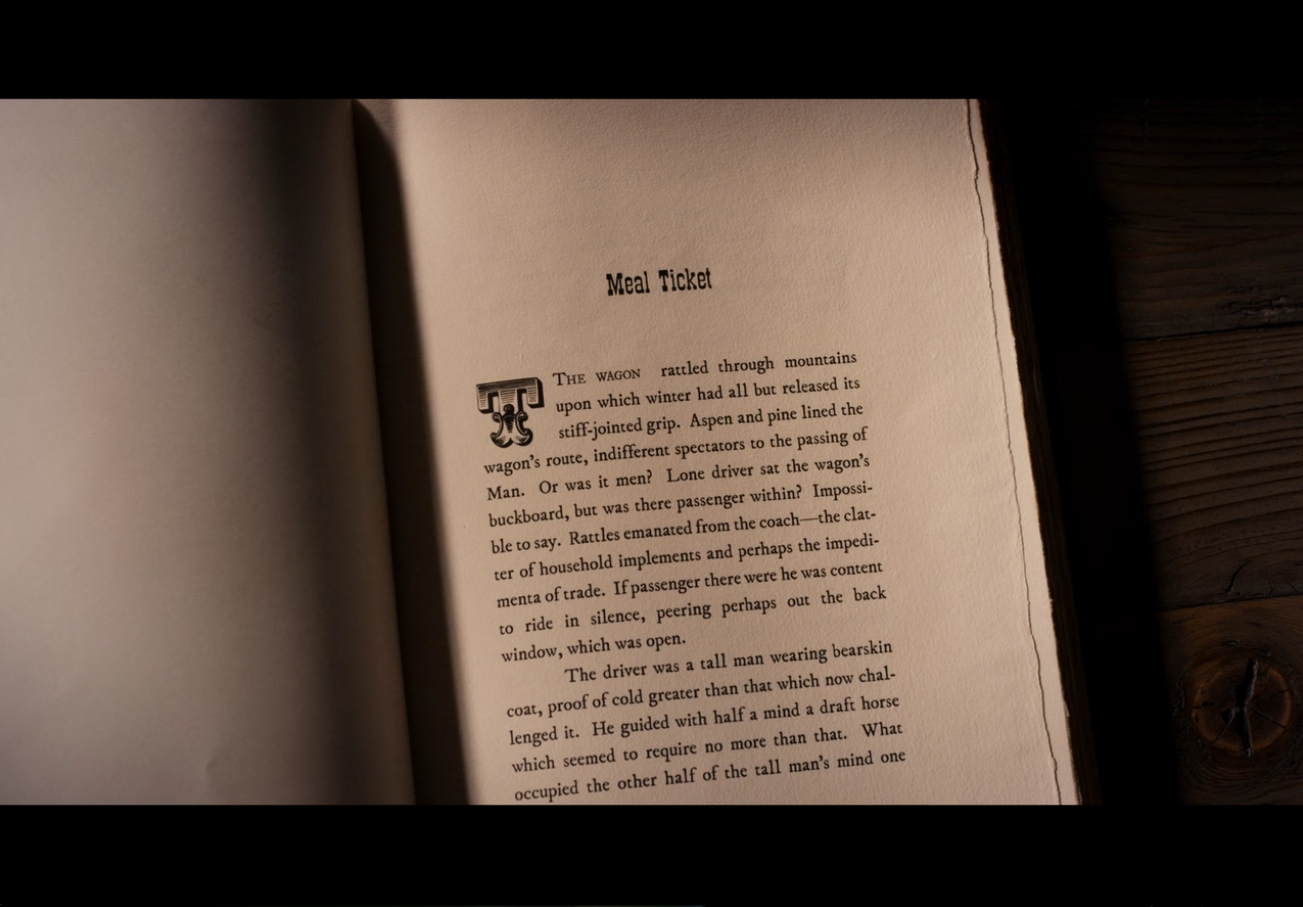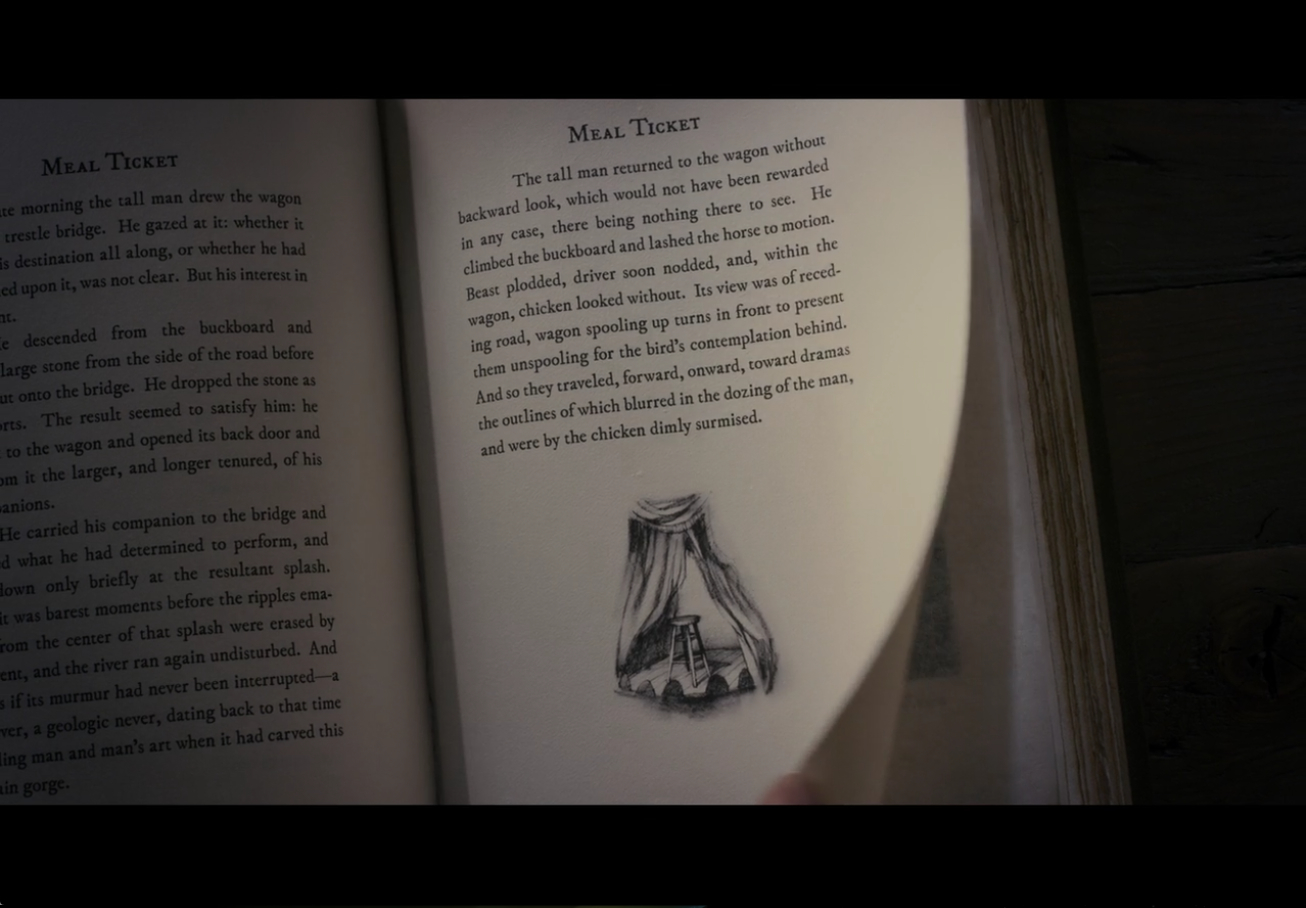I’m a fan of the Coen brothers. I don’t love every one of their movies, but The Big Lebowski is an all time favorite. So I felt optimistic about watching their latest film The Ballad of Buster Scruggs, an anthology of short stories set in the American Old West. I was immediately struck by the cynicism, black humor, and atrocity pervading the film. Clearly they were out to show some of the worst of human nature and circumstance, with a dash of their mellifluous and absurdist humor. You might say that this style should convince the viewer not to take the subject matter too seriously. Yet I think that presents too easy of an escape from any critique; and there are things here for which to take responsibility.
It was the third vignette, Meal Ticket, that most got under my skin. In fact, I turned it off and had to finish the rest later because I found it repeatedly offensive. I looked to see if anyone else had written anything related to my reaction. While there was a piece examining the portrayal of Native Americans in the film, I could only find one tweet from a disabled filmmaker referencing the ableism in this vignette. So I decided to give you this, featuring what I am calling The Classic Blunders of disability representation, dehumanizing devices all, which Meal Ticket expertly displays.
Classic Blunder #1: The Nondisabled Actor
Others have written already about this, as have I, so I won’t spend too much time here. This issue has resurfaced recently with Bryan Cranston being criticized for starring as a wealthy quadriplegic in The Upside, a remake of the 2011 French film The Intouchables. Suffice it to say, Hollywood should let disabled actors play disabled roles. Excuses for not doing this hinder diversity and equal representation, as well as keeping the realities of disability at arm’s length. While Harry Melling is fine as actors go, he is representing a culture that he is not a part of, and undoubtedly knows little about.
Classic Blunder #2: The “Supercrip” Trope & Inspiration Porn
Disabled characters often have a talent or skill—if not an outright superpower—that allows them to “overcome” their disability. Hence the term, “supercrip.” You can hardly come across a blind character without reference to how their “other senses” are heightened, so as to minimize concern, pity, or discomfort toward them—unless of course those are the intended reactions. “The Artist” in Meal Ticket has an excellent oratory ability, so that the audience does not question the value of his existence or contribution to society as it normally would. (By the way, “crip” is sometimes used as a reclamation of the offensive word “cripple,” so please don’t use it, as a noun or a verb, to describe a person, anxiety, debt, economy, or anything at all.)
Similarly, disabled folks are often overly praised for anything they do, large or small, despite their disability—as if simply existing in their condition is a superpower or heroic. There are countless internet memes that exemplify this.

The disabled person is legitimized by serving as an inspiration to the nondisabled audience. In these cases the disabled person becomes objectified, merely serving as a prop for inspiration and gratification, hence the term, “inspiration porn.” In watching Meal Ticket, you might notice thoughts like, “Wow, The Artist was able to make something of himself, doing what he loved. Why don’t I do more in my life?”
Classic Blunder #3: Desubjectification
I say desubjectification rather than objectification because in a story that otherwise revolves around a disabled character, it turns out to be told in a way that does not center their experience at all. By the end of Meal Ticket, it is clear the story is not told from the point of view of The Artist, but of The Impresario. This is established even in the fictitious storybook shown on-screen (though not long enough to be read without pausing) at the beginning and end of each vignette.

“Lone driver sat the wagon’s buckboard, but was there passenger within? Impossible to say. … If passenger there were he was content to ride in silence, peering perhaps out the back window, which was open.” The Artist’s very existence (i.e. his individuality, subjectivity, and humanity) is in question from the start, and if he is not in fact unnoticeable, then he is unknowable.
The story highlights the work that The Impresario puts into setting up the stage, doing The Artist’s makeup, collecting donations, and personal caregiving tasks such as assisting with meals and bathroom tasks. There was actually the potential for a poignant relationship between caregiver and recipient, a story of interdependence, especially with the wry humor inherent to having your ass wiped by another person day after day. This was disappointingly erased and revealed to be merely a plot device to increase the drama of the final scene.
The Artist himself never speaks outside of his performances, and we see almost no emotional reactions from him. It cements him as truly tragic, with no inner life nor engagement in the world. He is a dejected intellectual who has lost his love of language; which, as I have suggested already, is the proclivity that is meant to counterbalance the existential hardship of his disability.
Classic Blunder #4: Desexualization
Many disabled folks are seen as nonsexual: either they are not imagined able to participate in sexual situations or because they are deemed undesirable; similarly, nondisabled people mostly prefer not to think of disabled folks having sexual desire of their own. The Impresario of Meal Ticket is allowed to satisfy his sexual desires by hiring a sex worker. Again there is a tease of camaraderie as The Artist is brought along, but then literally turned away from the scene so he may not witness it (though presumably he can hear everything transpiring). The sex worker, not thinking to have The Artist speak for himself, asks The Impresario if he would buy sex for his friend—which he won’t—and if he ever has had a sexual experience—to which the ominous reply of—“Once”—is given. What a horrible experience for all involved that must have been, the audience is left to think.
The Final Blunder: Death
The Artist getting murdered was the last nail in the coffin for my finding any redemptive value in this story. His death is given less concern than any other in the whole anthology—even the life of the dog, President Pierce, seems to carry more weight. An off-screen death is further insult, though it can be read in the final pages of the storybook (partially obscured, but the content is clear), should any ambiguity remain.

It is also not difficult to rationalize that he was better off dead than to continue living as he was, and that is a problem. Am I saying that no disabled character should ever die in a story? No; but when so, so many of them do, what is the implication? The same problem exists with LGBT characters, spawning the trope/hashtag #BuryYourGays. In 2016 one writer counted 202 lesbian and bisexual characters to date killed off on tv alone. A similar trope exists for disability as well, “Bury Your Disabled” (note that Meal Ticket falls under Type 2 of this definition). I couldn’t find any tallies of disabled character deaths, but here is a non-exhaustive survey within classic literature and popular films.
Depictions of atrocity are often seen as “artistic,” but it is necessary to be mindful of how you represent them. Can you imagine Schindler’s List (another Liam Neesan film) being told from the point of view of the Nazis? Of course not; nor would we make another film like The Birth of a Nation. It’s also related to (evolved into?) the White Savior trope in movies like Dances with Wolves and The Last Samurai. It exoticizes and objectifies the very group being represented, though that often gets obscured by the romanticization. Quentin Tarantino writes extremely racist and misogynistic characters, making his films somewhat controversial and intriguing, and he gets away with it by including revenge-fantasy endings for the threatened minority characters (I’m thinking of Death Proof, Inglorious Basterds, Django Unchained, and The Hateful Eight in particular). Meal Ticket deals with its callous violence by choosing not to give its characters proper names in an attempt to universalize the story, pushing an allegorical interpretation, but further dehumanizing The Artist.
There are more suggestions that this story of murder should not be taken personally. The Artist recites a portion of Prospero’s speech from Shakespeare’s The Tempest:
Our revels now are ended: These our actors, / As I foretold you, were all spirits and, / Are melted into air, into thin air; … / We are such stuff / As dreams are made on, and our little life / Is rounded with a sleep.
In other words, don’t be alarmed, it’s nothing more than a bad dream. Further, in the final vignette, The Mortal Remains, Thigpen the “reaper” remarks on the nature of stories: “…We all love hearing about ourselves, so long as the people in the stories are us, but not us. Not us in the end especially.” This comment belies why The Artist is not meant to be identified with: so that the audience may remain comfortable and entertained. Some audience members however do not have the privilege of not identifying with The Artist.
Conclusion
Besides shifting the point of view away from the disabled experience, using a token disabled character also ignores the long history of exploitation, abuse, and violence against disabled people—and make no mistake that The Artist is a tokenized character. If you are using disability to portray the most vulnerable state a person can be in, then please also know the history of how that vulnerability has been hated and abused in society, individually and systematically. Think about if you want to continue the tired tradition using disability as a vulnerable/tragic plot hook; if you want to use disability to portray a person at their lowest—just don’t. There is so much more to disability than succumbing/overcoming, so much depth you would be missing.
Society is getting better about representing historically oppressed groups. So why is it still ok to use token disabled characters as metaphor, allegory, and philosophical masturbation? Where are our pulpy, gratuitous, revenge-fantasy endings? Can that even exist outside of the disabled villain archetype? Not until we rethink the roles that disability can fit into.
At first glance, The Artist is supposed to be the titular meal ticket, so you might still argue the story really is about him. But as I noticed the way he was chewed up and spit out by the narrative, and on display with his performance for the consumption of both the on-screen audience, and you, the Netflix audience, I came to a grim realization: The Artist is less the meal ticket, and more the meal.








What a great, tight piece of writing, Mike!
I watched this movie last night and while I was extremely troubled by the casting (no excuse for that, ever and it was the first thing we noticed when watching) don’t you think the story really was about exactly the exploitation that you highlight? The physical care appears tender to start with but it soon becomes obvious it’s grudging and impatient and depends on the crowd that night. The Artist is dehumanised, as the scene with the sex worker showed (and of course, she knew that), and the audience is aware that he is sinking into a justified depression. His powerlessness renders him mute, but he’s not unseeing and he anticipates the extreme violence he’s about to be subjected to when The Impresario chooses to replace his charge with a lucrative chicken. (I hope the chook froze to death on the back of the wagon). None of this takes away from your essential argument about the lack of agency usually given to disabled characters – you are dead right. For what it’s worth, I watched this cuddled up with my partner, an amputee musician and actor, and friend of many who could have played that role with just as much poignancy.
Hi Naomi, sorry for the much delayed reply. One the one hand, ok, yes this is a story about a bad person who does bad, exploitative things, and we pity The Artist as the victim. But this is not good representation, in my opinion, and does nothing to change the popular opinion of disabled people. I maintain that disability was merely used as a plot device, therefore replicating any objectification they attempted to portray.